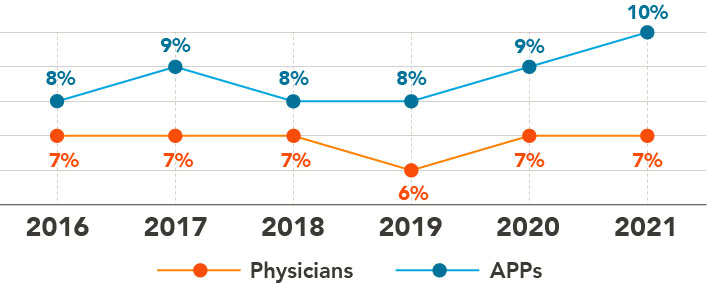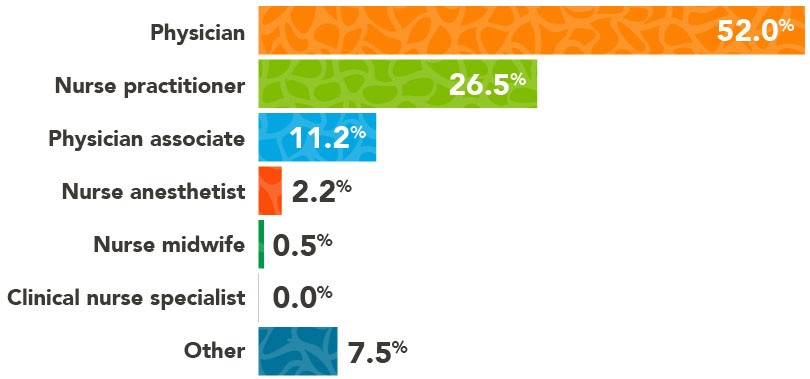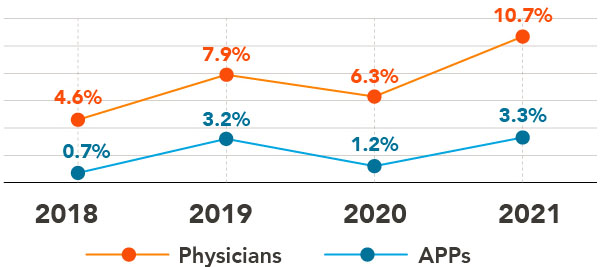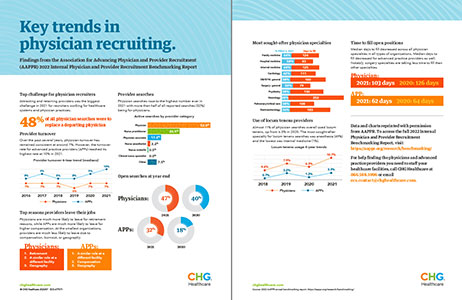
Key findings from the 2022 AAPPR benchmarking report that will help physician recruiters address the top challenges of their role.
Attracting and retaining providers continues to be the biggest challenge for recruiters working for healthcare systems and physician practices. According to the latest report from the Association for Advancing Physician and Provider Recruitment (AAPPR), nearly half of all physician searches (48%) conducted during the study period were to replace a departing physician. This rate has steadily increased over the past four years, climbing 16 percentage points since 2018.
1. Primary reason for provider turnover
Provider turnover has remained fairly consistent for physicians over the past several years. However, advanced practice providers (APPs) tend to leave more frequently than physicians. Turnover reached its highest rate at 10% for APPs in 2021.
Provider turnover 6-year trend

The top reasons physicians and APPs leave their jobs have some differences. Physicians tend to leave due to retirement, for a similar role at a different facility, and for reasons of geography. APPs leave due to finding a similar role elsewhere, compensation, and geography. The largest discrepancy between the two are retirement and compensation. Physicians are much more likely to leave for retirement reasons (32% vs. 5%) while APPs are much more likely to leave for compensation reasons (30% vs. 7%).
However, providers at the smallest organizations are much less likely to leave due to compensation, burnout, or geography. So, it’s important for recruiters in smaller facilities to remember that even though it takes longer to fill these jobs, once they’re filled, the providers are more likely to stay. Additionally, they’re less likely to retire early.
2. Physicians are in high demand
As demand for physicians remains high, the percentage of searches filled during 2021 decreased for the fourth year in a row. On average, APPs accepted 86% of offers extended to them, while physicians accepted 76% of their offers. In general, both physicians and APPs have accepted a higher percent of offers over the last 6 years.
In addition, physician searches rose to the highest number ever in 2021 with more than half of all reported searches (52%) being for physicians. However, only a quarter of organizations increased the size of their recruiting department, and nearly a third decreased in size.
Active searches by provider category

Advanced practice searches were used more frequently than in prior years. However, larger organizations were more likely to have a higher percentage of active searches for APPs versus smaller organizations.
Although reported searches rose, the percentage of provider searches still open at year-end increased in 2021, reaching 47% for physicians and just under 32% for APPs.
Status of searches, as of 12/31/21

“We're just having to get more competitive,” says Megan Zielinski, senior physician recruiter for Mercy Health and chair of AAPPR's research committee. “It’s asking candidates what their other offers are, what's out there, making sure our compensation plans are competitive, and really putting our best foot forward. Since COVID, people are looking all over instead of just tied to one geographic area, so you really have to be competitive not only with those organizations right within your area but also nationwide.”
3. Most sought-after physician specialties
As in past years, primary care specialties like family medicine, internal medicine, and hospital medicine are the most sought-after specialties, making them among the most competitive positions to fill.
Most common physician searches

Physician positions least likely to be filled include otorhinolaryngology, dermatology, and urology.
4. Use of locum tenens has increased
Approximately 11% of physician searches overall used locum tenens. The most sought-after specialty for locum tenens searches was anesthesia (49%) with internal medicine being the lowest at nearly 1%. Location desirability seems to impact the use of locum tenens, with organizations in rural or less popular regions being more likely to use locum tenens to provide coverage while searching for a permanent replacement.
Locum tenens usage 4-year trends

5. Time needed to fill positions decreased
In 2021, it took 103 days to fill the typical physician search and 62 days for an APP search, a decline from the previous year. Most notably, surgeons are taking less time to fill than other specialties, and smaller organizations and those in more rural or less attractive areas require more time to fill their searches.
Endocrinology/metabolism rated the longest median time to fill (265 days), and family medicine – the most in-demand position in 2021 – typically filled in 124 days, which is 31 days less than reported in 2020.
6. Recruiters are doing more with less
Recruiters averaged 42 (35 median) searches during the year, with 15 – 21 searches active at any point in time — an increase in 2021. Because of the level of attention required to source, recruit, and hire just one physician is so high, what may seem like a modest increase actually reflects a significant increase in a recruiter’s workload.
The typical recruitment department in 2021 employed four team members (two recruiters and two other staff members). Most departments have at least one staff member whose role is mostly a support function. As a result of the increased department staff, recruiters were asked to focus more on recruiting responsibilities.
To help recruiters save much-needed time, Zielinski suggests utilizing the latest technology, such as an applicant tracking system.
“Using an applicant tracking system saves so much time,” she says. “If you look at people who have one compared to people who do it themselves with Excel sheets, there's so much more information and data you can have in an applicant tracking system to build a pipeline and keep track of people and where they're at in the process. It really is a one-stop shop for everything and saves a lot of time.”
If your budget doesn’t allow you to add more tools, Liz Mahan, MFA, CPRP-DEI, director of professional development & solutions for AAPPR, suggests staying up to date on the latest feature updates with the tools you’re already using.
“For those organizations who have tools, but their budgets don’t allow them to add more, I recommend reaching out to whichever vendor you're working with for your sourcing platforms or your ATS just to get a quick refresher on what updates they've done to make sure you're using the tools to their full capability.”
She adds, “These platforms come out with new integrations and new features all the time, so every 18 months or so, take the time to make sure you're really flexing and stretching things to their max. It could make a difference in terms of your efficiency and your results.”
7. Annual recruitment budgets dropped
For the fourth straight year, departments have tried to manage their costs by decreasing their budgets. This means they’re relying more heavily on recruiters instead of spending money on a search agency. However, this didn’t result in recruiters being more highly compensated.
8. Recruiter salary decreased and turnover increased
The typical recruiter's salary decreased 2% in 2021. However, compensation is generally boosted by experience and supervising staff.
In addition, recruiter turnover hit its highest level in four years. More than one-fifth of recruiters left their positions during 2021 with larger organizations experiencing less turnover than smaller organizations.
Recruiter turnover (average) 4-year trend

“Virtual has opened many doors for in-house recruiters, and teams are becoming more and more distributed across the country than ever before. Even recruitment hiring leaders love being able to pull from different areas across the country,” says Carey Goryl, MSW, CAE, chief executive officer of AAPPR. “They also sometimes leave the field. Within the first year, it seems that many people sort of figure out if this is their type of work or not. Typically, if they've lasted three years or more in this role, it's probably something that they'll do for quite a while longer.”
Making the business case to get the resources your department needs
To remain competitive, it’s important for recruiters to build the business case to get the tools and resources they need.
“We've seen recruiting departments make business cases to expand their teams and get more resources by looking at the number of searches they have and then using The Missing Physician to calculate how much revenue an organization is losing day to day or month to month,” Mahan shares. “Then take that data and show how hiring a new recruiter can benefit the organization. For example, you could show how getting your days to fill and your productivity in line with national benchmarks can bring more revenue into the organization faster and get more patients seen quicker. Sometimes that has an even further downstream effect where you know suddenly your quality surveys and patient satisfaction surveys are going up, and your top-box scores are looking better because people aren't waiting as long and seeing quality physicians sooner.”
MORE INFO: AAPPR annual benchmarking report
Download executive summary: Key trends in physician staffing

For help finding the physicians and advanced practice providers you need to staff your healthcare facilities, give us a call at 866.588.5996 or email ecs.contact@chghealthcare.com.